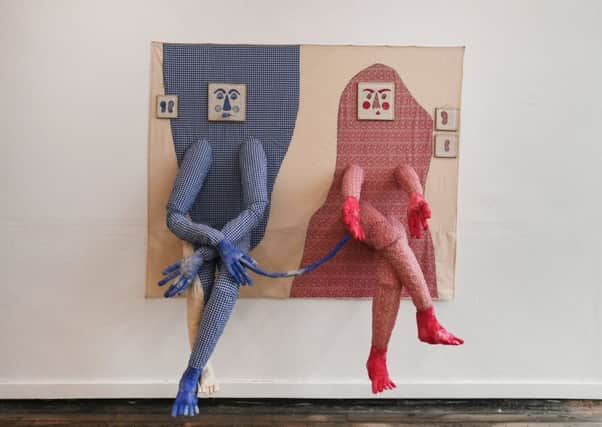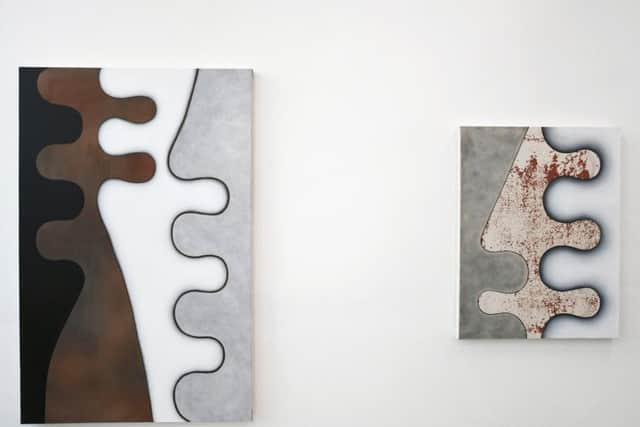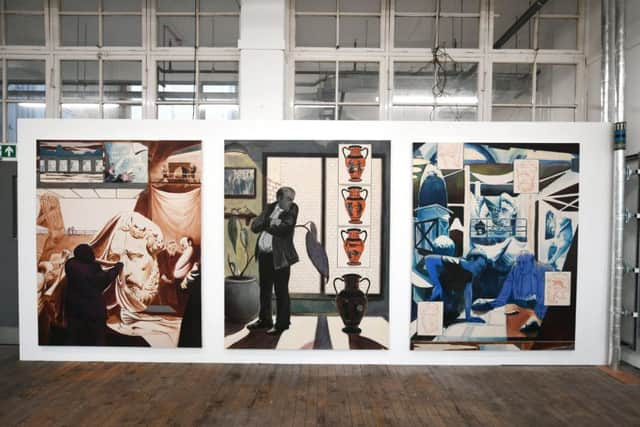Art reviews: GSA Degree Shows


GSA Degree Show 2019, Stow Building, Glasgow ****
MFA Degree Show, Glue Factory, Glasgow ****
That said, GSA boasts over 130 graduating students in Fine Art alone, making the show as much of a marathon as ever. Small changes – bigger name labels and clearer labelling of work in shared rooms – would make it easier, as would some basic information about each student’s work, but few provide this. One wonders what (if any) discussions go on in class about presenting work in an accessible way. After 100 students and what feels like a mile of walking, one hopes there is some truth in Emma Hillcoat’s perspex sign: “One day this will all make sense.”


Making sense of the world is, in one sense, what art school is about, and the enormous variety of ways students find to do this is one of the things which makes degree shows so interesting. Here, there is painting (more than usual), sculpture, print-making, film, drums that house audio recordings, a playlist of pop songs recorded in people’s bedrooms and a climbing wall made with footholds made of glass.
Advertisement
Hide AdAdvertisement
Hide AdThe act of making is very much in evidence, as it was at Dundee’s degree show last month. Meabh Breathnach covers the floor of her space with beautifully crocheted tiles which (if I’ve understood this correctly) will gradually wear away as people walk on them; Rosa Hackett explores the figure by making limbs out of fabric; Esther Lovell’s ceramic vessels have a weight and seriousness to them, while Ivy Batten Deacon’s – which play pop songs – are correspondingly light.
Maija Fox has made an impressive wooden table as a tool to make her stop, think and absorb the landscape, and took it with her on a journey to Finland. Jin Wei describes his practice as beginning with a fear of white space, which he then goes on to fill with a mixture of drawing, stitching, printed textiles and metalwork, all executed with a high level of skill.
Several artists have built machines with moving parts: Florence Eckersley uses robotics to make two disks which gradually reduce her meticulous black and white chequerboard to a mess of grey dust. Others use a variety of media to create whole environments – I counted two offices, two hairdressing salons and a betting shop. Lucy Colbert’s wellness studio houses sculptural objects which might be supports for the body and might be restraints, while Samantha Dick has made an unsettling life-size doll’s house out of cardboard.


It is heartening to see painting throughout the show, and to see young artists applying themselves to it with care and skill. Polly Pentreath’s paintings of modernist architecture are quietly evocative, as are Siannon McLeod’s interiors, which focus on overlooked details. Louis Nye creates a substantial body of work using stitching and weaving as well as painting on jute-like fabric.
Jack McGarrity’s large-scale works explore a narrative to do with monumental sculpture; his draughtsmanship has real flair. Kirsten Shanks works in pastels, making fine, ethereal drawings exploring the human form. Kyle McGhee’s impressive reliefs made from wood and metal sit somewhere between painting and sculpture, and Sean Ellcombe explores fields of colour in a series of large-scale abstracts.
There are also printmakers who are serious about what they’re doing. Margot Kirk dares to be minimal, exploring what her medium can do and drawing on the textures produced by the presses themselves. Almudena Rocca does almost the opposite with bright abstract prints which nod to Miro.
Several students explore our relationship with the natural world. Linden Kingston looks at the loss of wilderness through photographs, artist books and storytelling. Another photographer, Ruby Pluhar, explores individual relationships with animals with an excellent series about parrots and their owners. Toby Mills brings nature right into the show with his tank of live eels, gently making the point that European eels are now critically endangered, while Lucy Mullican paints beautiful work with dyes made from natural materials.
Advertisement
Hide AdAdvertisement
Hide AdMeanwhile, Glasgow’s highly acclaimed MFA course runs its own show in the grungy surroundings of the Glue Factory, this year featuring 25 graduates from all over the world. High levels of ambition and a high degree of finish make this a show verging on professional standard.
Here, too, making is very much in evidence, from Emily Chudnovsky’s vessels woven from wool and hand-made copper chainmail to Jack McCombe, who taught himself how to plaster a wall, then built a space to house his Whistling Symphony, itself a labour of love, whistled, recorded and mixed on six channels.
ME Smit-Dicks, who has a backgroud in costume design, makes sculptures in skin-coloured fabric which are weirdly suggestive of bodies, playing with the qualities of hard and soft materials. Zoe Kirkwood has engineered and built a kinetic sculpture of a slowly swaying pendulum which is also a model of Brunelleschi’s dome. Sam Dransfield creates musical instruments out of breezeblocks which can be played by blowing into them.
That’s not to say that all the MFA graduates are makers, but there is a ubitquitous sense of time and care being applied to the work, whether it involves learning a traditional craft or making a videogame (Alistair Grant), a documentary film (Lauren La Rose), or transforming yourself into a movie femme fatale (Hio).
A great deal of thought is also given to how the work is displayed, from Chuchu Tang’s dream diaries – complete with disturbing fabric sculptures – to Justin Apperley’s photographs, inspired by living off-grid in Canada, printed on to the backs of old road signs. As interesting as they are diverse, these artists are more than ready to bring their own unique perspectives into the professional world of contemporary art. - Susan Mansfield
Both shows until 9 June